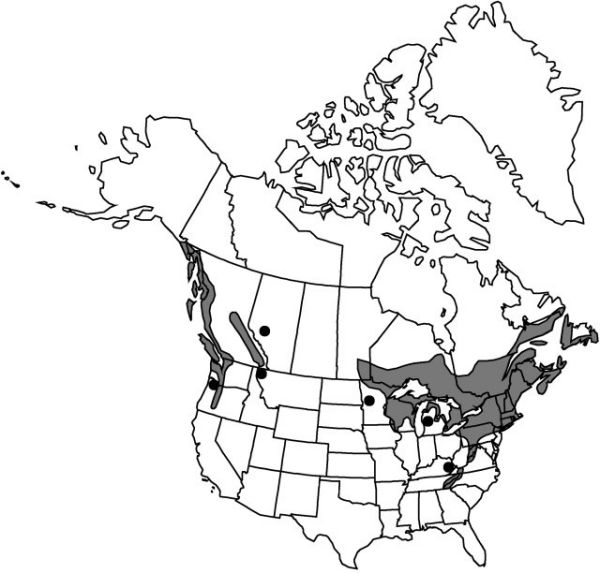Streptopus lanceolatus
Phytologia 74: 187. 1993.
Plants from slender, sometimes matted rhizomes with variable internode lengths. Stems simple or occasionally branched, 1.5–4 (–8) dm, glabrous, nodes sparsely pubescent-fringed. Leaves 5–10 × 2–4.5 cm; blade ovate-elliptic, base rounded, margins finely glandular-pubescent, apex acute to acuminate; peduncle: junction with pedicel not abrupt, entire structure (5–) 9–20 mm, glands absent or obscure. Flowers 1 (–2) per axil; perianth campanulate; tepals slightly spreading but not recurved, white or greenish yellow, streaked or spotted with pale rose to reddish purple, narrowly oblong-lanceolate, 6–10 mm; stamens 5–8 mm; anthers 2 mm, apex 2-pointed; style slender, 3.5–4 mm; stigma weakly 3-lobed; combined peduncles and pedicels recurved, (5–) 9–20 mm, glands absent or obscure; pedicel rarely geniculate at junction with peduncle, coarsely pubescent. Berries reddish purple to red, subglobose, 6–9 mm. Seeds 2.5–3 mm. 2n = 16, 48.
Phenology: Flowering late spring–mid summer.
Habitat: Rich moist coniferous and deciduous woods
Elevation: 50–2000 m
Distribution

St. Pierre and Miquelon, Alta., B.C., Man., N.B., Nfld. and Labr., N.S., Ont., P.E.I., Que., Alaska, Conn., Iowa, Ky., Maine, Md., Mass., Mich., Minn., Mont., N.H., N.J., N.Y., N.C., Ohio, Oreg., Pa., R.I., Tenn., Vt., Va., Wash., W.Va., Wis.
Discussion
Streptopus lanceolatus has replaced the long-used name S. roseus, based on the recent lectotypification (J. L. Reveal 1993d) of Aiton’s Uvularia lanceolata. This widespread North American species has been divided into four intergrading varieties or races (N. C. Fassett 1935) based on variation in rhizome internode lengths and density of leaf-margin ciliation. These include var. roseus in the southern Appalachians, var. longipes in the western Great Lakes region, var. lanceolatus (= var. perspectus Fassett) in the northeast, and var. curvipes in the west.
Selected References
None.
Lower Taxa
"broad" is not a number."thicker" is not a number."dm" is not declared as a valid unit of measurement for this property."dm" is not declared as a valid unit of measurement for this property.